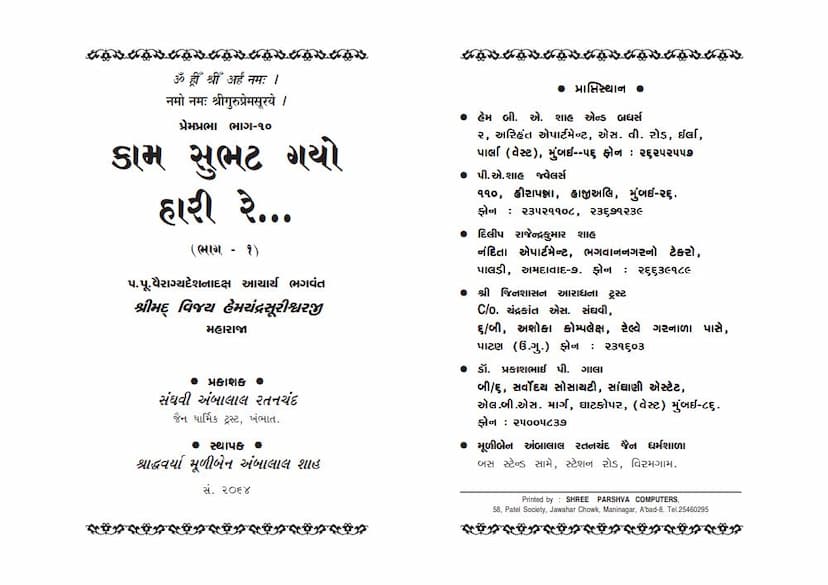Kam Subhat Gayo Hari Re
Added to library: September 2, 2025

Summary
Here's a comprehensive summary of the Jain text "Kam Subhat Gayo Hari re," authored by Acharya Hemchandrasuri:
Title: Kam Subhat Gayo Hari re (The Warrior of Desire is Defeated)
Author: Acharya Hemchandrasuri
Publisher: Sanghavi Ambalal Ratanchand Jain Dharmik Trust
Overall Theme: The book is a profound discourse on Brahmacharya (celibacy) and its crucial role in conquering Kama (lust/desire), personified as the formidable warrior "Kam Subhat." It emphasizes the power of Brahmacharya to achieve spiritual liberation and highlights the teachings and life of Acharya Shri Vijay Premsurishwarji Maharaj.
Key Concepts and Structure:
-
The Nature and Power of Kam Subhat:
- Kam Subhat is described as a universal enslaver, controlling all beings across the realms of existence.
- Even the most powerful beings, like Chakravarti emperors and celestial beings, are often subjugated by it.
- The text illustrates the destructive nature of Kam Subhat through numerous examples from Jain scriptures, detailing how it leads to downfall, immense suffering, and rebirths in lower realms (hells, animal kingdoms).
- It causes the loss of spiritual progress, merit, and even liberation itself.
-
Brahmacharya as the Victor:
- The text strongly advocates for Brahmacharya as the primary means to defeat Kam Subhat.
- It explains that the path of Brahmacharya is difficult but leads to ultimate happiness and liberation.
- The importance of observing Brahmacharya in thought, word, and deed is stressed.
-
The "Nine Fences" (Nava Vado) of Brahmacharya:
- To make the practice of Brahmacharya more manageable and effective, the scriptures have outlined "nine fences" or protective measures. These are:
- Vasati (Residence): Choosing secluded and appropriate places to live, avoiding proximity to women's quarters or places of worldly attraction.
- Katha (Talk/Conversation): Avoiding discussions about women, worldly pleasures, or engaging in frivolous talk.
- Nishiddha (Prohibited Actions): Avoiding actions that are specifically forbidden for monks and nuns.
- Indriya (Senses): Controlling the senses, especially sight, hearing, taste, smell, and touch, from indulging in sensual objects.
- Kuthantar (Enclosures/Partitions): Avoiding places where women's voices or activities are heard through walls or partitions.
- Purvakilia (Past Enjoyments): Not reminiscing about past sensual indulgences from previous lives or household existence.
- Praneeta Aahar (Refined/Delicately Prepared Food): Avoiding foods that are overly stimulating or prepared with refined ingredients (like specific dairy products, sweets), as they can increase desire.
- Aatimatra Aahar (Excessive Food): Avoiding overeating, which can lead to dullness and increased sensual urges.
- Vibhusha (Adornment): Abstaining from decorating the body, wearing fine clothes, or engaging in beautification practices, as these attract attention and foster desire.
- To make the practice of Brahmacharya more manageable and effective, the scriptures have outlined "nine fences" or protective measures. These are:
-
The Tenth Aspect (Samadhi Sthana):
- The text further elaborates on a tenth aspect, often considered a part of the "Samadhi Sthana" or states of mental composure, which is avoiding attachment to:
- Shabda (Sound): Pleasant or suggestive sounds from the opposite sex.
- Rupa (Form): The attractive forms of the opposite sex.
- Gandha (Smell): Pleasant fragrances that can evoke desire.
- Rasa (Taste): Delicious or stimulating tastes.
- Sparsha (Touch): Soft or alluring physical contact.
- These five are identified as primary drivers of Kama.
- The text further elaborates on a tenth aspect, often considered a part of the "Samadhi Sthana" or states of mental composure, which is avoiding attachment to:
-
The Example of Acharya Vijay Premsurishwarji Maharaj:
- A significant portion of the book is dedicated to eulogizing Acharya Vijay Premsurishwarji Maharaj as a paragon of Brahmacharya.
- His life is presented as an example of extreme dedication, purity, and the power of Brahmacharya to achieve spiritual heights, lead a large community of monks, and inspire countless others.
- Anecdotes are shared highlighting his strict adherence to Brahmacharya, his compassionate guidance, and the miracles attributed to his spiritual power.
- His teachings to his disciples emphasize the importance of vigilance, detachment, and unwavering commitment to Brahmacharya, even in old age.
-
The Severity of Violating Brahmacharya:
- The text repeatedly warns against any lapse in Brahmacharya, comparing it to deadly poisons or fierce animals.
- Even seemingly minor lapses, like prolonged observation of the opposite sex or improper association, are shown to lead to grave consequences, including downfall from spiritual practice and rebirth in lower realms.
- The importance of introspection, confession (prayaschitta), and seeking forgiveness from a Guru for any breaches is stressed.
-
The Fruits of Brahmacharya:
- The book details the immense benefits of practicing Brahmacharya:
- Attainment of mental peace and equanimity (samadhi).
- Development of immense inner strength and spiritual power (sattva).
- Attainment of knowledge, virtuous qualities, and auspicious karma.
- The ability to achieve all spiritual goals and ultimately attain liberation (moksha).
- The reverence of celestial beings.
- The book details the immense benefits of practicing Brahmacharya:
-
Detailed Analysis of the Nine Fences:
- Each of the nine fences is explained in detail, providing specific guidelines and examples of how to uphold Brahmacharya in daily monastic and even householder life (where applicable).
- The text emphasizes that even when interacting with one's own mother, sister, or daughter, maintaining appropriate distance and avoiding suggestive conversations is crucial to prevent mental contamination.
-
The Role of the Laity:
- While primarily aimed at monks and nuns, the text also implicitly guides lay Jains (shravakas and shravikas) in supporting the monastic community and maintaining their own ethical conduct (shil).
In essence, "Kam Subhat Gayo Hari re" is a powerful and detailed guide to understanding and practicing Brahmacharya as the ultimate weapon against lust and desire. It uses scriptural examples, the exemplary life of a revered Acharya, and practical guidelines to inspire and guide its readers towards spiritual purity and liberation.